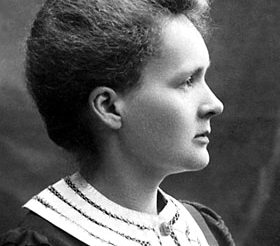Just Imagine…Biases Impeding Innovation – Interactivity Foundation – Engaging citizens in the exploration and development of possibilities for public policy.

Marie Curie 1903, via Wikimedia
Today we look up to Marie Curie as one of the pioneers in the study of radioactivity. She is one of only two scientists to win a Nobel Prize in two different fields (chemistry and physics). She was the first woman to win a Nobel Prize. But for all of her breakthrough work, she continually faced gender biases that impeded her along the way.
When the Nobel Prize Committee initially considered the awarding of the Nobel Prize for advances in the understanding of radiation, they intended the award to recognize only the men involved in this research, Marie’s husband Pierre and Henri Becquerel. After Pierre complained of her omission, Marie’s name was added to the award.
We often consider the Curies as partners in scientific innovation, but after Pierre Curie’s untimely death, Marie continued to break new ground. Her second Nobel Prize came eight years after his death. Despite winning two Nobel prizes, Marie was rejected by the French Academy of Sciences for membership. It took another 50 years before a woman was elected to join the Academy.
Marie Curie’s encounter with gender bias in the acceptance of innovative breakthroughs was, of course, not an isolated experience. Barbara McClintock pioneered the understanding of how genes function. Her pioneering work was critical in the eventual development of the COVID-19 vaccines. Yet, during her career, McClintock’s work was so disparaged by her male colleagues that she quit publishing the results of her work.
Similarly, Suzanne Simard discovered underground networks of fungi and roots in forests. These networks help us understand how trees in forests actually communicate and provide support for each other, even across species. Her work was initially ridiculed by her colleagues. Now it is widely accepted.
Why do we tend to discuss innovative breakthroughs when they come from those who don’t belong to “innovation fraternity”? The sad truth is that STEM professions as well as other academic areas are subject to the same power structures that dominate in the rest of society. Those who bestow recognition come to expect that breakthroughs will come from people who look like them. Beyond appearances, people also expect that innovation will come from those who attended elite schools, those who were mentored by leaders in their profession, or those who were provided with unparalleled resources. The reality is that innovative breakthroughs tend to come from minds that don’t fit the world. Often, they come from those who don’t have the pedigrees or resources of those who were more privileged.
Just imagine what our society would be without the will and the determination of those who faced constant discouragement or exclusion—and who nevertheless persisted. Just imagine what it would take to eliminate traditional biases that block innovation. What roadblocks do we still struggle to identify? In a society that encourages diversity and inclusion, how might we remove the bias of elitism that hinders truly useful innovations?
As we seek to identify and remove these barriers that our biases create, we should also remember how powerful it is when an innovator breaks through them. For a sign of this, we can look to the career of Irène Curie, Marie’s daughter. She followed her mother’s pathbreaking work and went on to win a Nobel Prize herself.
“You can’t allow tradition to get in the way of innovation. There’s a need to respect the past, but it’s a mistake to revere your past.” – Bob Iger (Former CEO of Walt Disney Company)
This is part of our “Just Imagine” series of occasional posts, inviting you to join us in imagining positive possibilities for a citizen-centered democracy.
